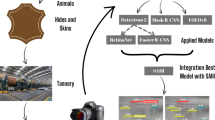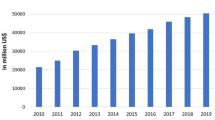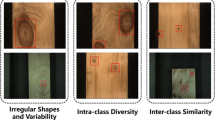Abstract
For the sake of better achieving the productivity of leather damage detection in industrial production, this paper proposes a Robust Breakage Detection Network (RBD-Net) model for leather breakage detection. The model is an optimized model of You Only Look Once (YOLO) v5 to identify and detect the degrees of damage in leather and the type of damage in leather without any damage from the image. Firstly, the backbone network is replaced by Cross Stage Partial Densely Connected Networks (CSP-DenseNet), which can better achieve the reuse of features and prevent the loss of excessive gradient flow information; secondly, Bi-directional Feature Pyramid Network (BiFPN) is added in the feature refinement stage, which can better balance the feature information at different scales; finally, the addition of the Decision Network allows for capturing not only local shapes, but also global shapes spanning a large area of the image to better identify leather breakage in the image. By conducting experiments and making comparisons, it concludes that the method performs better than existing detection models in both breakage detection, and the accuracy of cutting, etched surface, brand stigma, hole and bleaching of five types of leather is 83.9%, 80.4%, 82.4%, 95.5%, and 89.4%, respectively, which satisfies the requirement for the balance of accuracy and robustness in industrial production, and also provides some ideas for other breakage detection research.










Similar content being viewed by others
References
Anshori, M. F., Purwoko, B. S., Dewi, I. S., et al. (2020). Cluster heatmap for detection of good tolerance trait on doubled-haploid rice lines under hydroponic salinity screening. In IOP conference series: earth and environmental science (vol. 484(1), p. 012001). IOP Publishing.
Ashkzari, A., & Azizi, A. (2014). Introducing genetic algorithm as an intelligent optimization technique. Applied Mechanics and Materials, 568, 793–797.
Azizi, A. (2017). Introducing a novel hybrid artificial intelligence algorithm to optimize network of industrial applications in modern manufacturing. Complexity. https://doi.org/10.1155/2017/8728209
Azizi, A. (2019). Hybrid artificial intelligence optimization technique. Applications of Artificial Intelligence Techniques in Industry, 4, 27–47.
Azizi, A., Entessari, F., Osgouie, K. G., et al. (2014). Introducing neural networks as a computational intelligent technique. Applied Mechanics and Materials, 464, 369–374.
Bhatt, P. M., Malhan, R. K., Rajendran, P., et al. (2021). Image-based surface defect detection using deep learning: A review. Journal of Computing and Information Science in Engineering, 21(4), 040801.
Bochkovskiy, A., Wang, C. Y., Liao, H. Y. M. (2020). Yolov4: Optimal speed and accuracy of object detection. arXiv preprint arXiv:2004.10934.
Bolya, D., Zhou, C., Xiao, F., et al. (2019). Yolact: Real-time instance segmentation. Proceedings of the IEEE/CVF International Conference on Computer Vision (pp. 9157–9166).
Bong, H. Q., Truong, Q. B., Nguyen, H. C., et al. (2018) Vision-based inspection system for leather surface defect detection and classification. In Conference on information and computer science (NICS) IEEE (pp. 300–304).
Brock, A., Lim, T., Ritchie, J. M., et al. (2016). Generative and discriminative voxel modeling with convolutional neural networks. arXiv preprint arXiv:1608.04236.
Cadirci, B. H., Ozgunay, H., Vural, C., et al. (2010). A new defect on leather: Microbial bio-film. Journal of the American Leather Chemists Association, 105(04), 129–134.
Chaturvedi, S. S., Tembhurne, J. V., & Diwan, T. (2020). A multi-class skin cancer classification using deep convolutional neural networks. Multimedia Tools and Applications, 79(39), 28477–28498.
Cole, B. T., Ozdemir, P., & Nawab, S. H. (2012). Dynamic SVM detection of tremor and dyskinesia during unscripted and unconstrained activities. In Annual international conference of the IEEE engineering in medicine and biology society (pp. 4927–4930).
Deng, J., Wu, C., Liang, H., et al. (2020). Research on classification of leather defects based on a parameter-optimized residual network. Science Technology and Engineering, 20(8), 3143–3148.
Fang, Y., Guo, X., Chen, K., et al. (2021). Accurate and automated detection of surface knots on sawn timbers using YOLO-V5 model. BioResources, 16(3), 5390–5406.
Gan, Y. S., Liong, S. T., Zheng, D., et al. (2021). Detection and localization of defects on natural leather surfaces. Journal of Ambient Intelligence and Humanized Computing. https://doi.org/10.1007/s12652-021-03396-2
Georgieva, L., Krastev, K., & Angelov, N. (2003). Identification of surface leather defects. CompSysTech, 3, 303–307.
Ghiasi, G., Lin, T. Y., & Le, Q. V. (2019). NAS-FPN: Learning scalable feature pyramid architecture for object detection. In Proceedings of the IEEE/CVF conference on computer vision and pattern recognition (pp. 7036–7045).
Ghoulem, K., Kormi, T., & Bel Hadj Ali, N. (2020). Damage detection in nonlinear civil structures using kernel principal component analysis. Advances in Structural Engineering, 23(11), 2414–2430.
Gowthaman, K., Vikram, S., Fathima, N. N., et al. (2014). Solving vein marks defects problem through wet end process. Journal of the American Leather Chemists Association, 109(09), 278–283.
He, K., Zhang, X., Ren, S., et al. (2016). Deep residual learning for image recognition. In Proceedings of the IEEE conference on computer vision and pattern recognition (pp. 770–778).
He, K., Gkioxari, G., Dollár, P., et al. (2017). Mask r-cnn. In Proceedings of the IEEE international conference on computer vision (pp. 2961–2969).
Hoang, K., & Nachimuthu, A. (1996). Image processing techniques for leather hide ranking in the footwear industry. Machine Vision and Applications, 9(3), 119–129.
Hong, C., Wang, X., Yu, W., et al. (2021). Leather defect detection based on improved bilateral filtering. Laser Technology, 45(3), 373–377.
Huang, G., Liu, Z., Van Der Maaten, L., et al. (2017). Densely connected convolutional networks. In Proceedings of the IEEE conference on computer vision and pattern recognition (pp. 4700–4708).
Ioffe, S., & Szegedy, C. (2015). Batch normalization: Accelerating deep network training by reducing internal covariate shift. In International conference on machine learning (pp. 448–456).
Jawahar, M., Babu, N. K., Vani, K., et al. (2021). Vision based inspection system for leather surface defect detection using fast convergence particle swarm optimization ensemble classifier approach. Multimedia Tools and Applications, 80(3), 4203–4235.
Jawahar, M., & Vani, K. (2019). Machine vision inspection system for detection of leather surface defects. Journal of the American Leather Chemists Association, 114(1), 10–19.
Li, X., Su, H., & Liu, G. (2020). Insulator defect recognition based on global detection and local segmentation. IEEE Access, 8, 59934–59946.
Lian, J., Jia, W., Zareapoor, M., et al. (2020). Deep-learning-based small surface defect detection via an exaggerated local variation-based generative adversarial network. IEEE Transactions on Industrial Informatics, 16(2), 1343–1351.
Lin, T. Y., Dollár, P., Girshick, R., et al. (2017a). Feature pyramid networks for object detection. In Proceedings of the IEEE conference on computer vision and pattern recognition (pp. 2117–2125).
Lin, T. Y., Maire, M., Belongie, S., et al. (2014). Microsoft coco: Common objects in context. In European conference on computer vision (pp. 740–755).
Lin, T. Y., Goyal, P., Girshick, R., et al. (2017b). Focal loss for dense object detection. In Proceedings of the IEEE international conference on computer vision (pp. 2980–2988).
Liu, Y., Liu, X., Fan, S., et al. (2021a). Single-phase-to-ground fault line selection method based on STOA-SVM. Journal of Physics: Conference Series, 2095, 012029.
Liu, J., Zhao, Y., Jia, W., et al. (2021b). DLNet: Accurate segmentation of green fruit in obscured environments. Journal of King Saud University-Computer and Information Sciences. https://doi.org/10.1016/j.jksuci.2021.09.023
Liu, S., Qi, L., Qin, H., et al. (2018). Path aggregation network for instance segmentation. In Proceedings of the IEEE conference on computer vision and pattern recognition (pp. 8759–8768).
Moganam, P. K., & Seelan, D. A. S. (2020). Perceptron neural network based machine learning approaches for leather defect detection and classification. Instrumentation, Mesures, Métrologies, 19(6), 421–429.
Mohammed, K. M. C., Kumar, S. S., & Prasad, G. (2020). Optimized fuzzy c-means clustering methods for defect detection on leather surface. Journal of Scientific and Industrial Research (JSIR), 79(9), 833–836.
Nouretdinov, I., Gammerman, J., Fontana, M., et al. (2020). Multi-level conformal clustering: A distribution-free technique for clustering and anomaly detection. Neurocomputing, 397, 279–291.
Qi, S., Yang, J., & Zhong, Z. (2020). A review on industrial surface defect detection based on deep learning technology. In 3rd international conference on machine learning and machine intelligence (pp. 24–30).
Rana, N., & Arora, S. (2021). A review on surface defect detection of solar cells using machine learning. In Soft computing for intelligent systems (pp. 385–395).
Redmon, J., & Farhadi, A. (2018). Yolov3: An incremental improvement. arXiv preprint arXiv:1804.02767.
Ren, S., He, K., Girshick, R., et al. (2015). Faster r-cnn: Towards real-time object detection with region proposal networks. Advances in Neural Information Processing Systems, 28. https://proceedings.neurips.cc/paper/2015/file/14bfa6bb14875e45bba028a21ed38046-Paper.pdf
Ronneberger, O., Fischer, P., Brox, T. (2015). U-net: Convolutional networks for biomedical image segmentation. International Conference on Medical Image Computing and Computer-Assisted Intervention, (pp. 234–241).
Serafim, A. F. L. (1991). Multiresolution pyramids for segmentation of natural images based on autoregressive models: Application to calf leather classification. In International conference on industrial electronics, control and instrumentation IEEE (pp. 1842–1847).
Shi, H., Kang, X., Niu, L., et al. (2020). Application of principal component analysis method for micro-resonator weak resonant signal detection. Review of Scientific Instruments, 91(8), 085002.
Tabernik, D., Šela, S., Skvarč, J., et al. (2020). Segmentation-based deep-learning approach for surface-defect detection. Journal of Intelligent Manufacturing, 31(3), 759–776.
Tan, M., Pang, R., & Le, Q. V. (2020) Efficientdet: scalable and efficient object detection. In Proceedings of the IEEE/CVF conference on computer vision and pattern recognition (pp. 10781–10790).
Tian, Z., Shen, C., Chen, H., et al. (2019). Fcos: Fully convolutional one-stage object detection. In Proceedings of the IEEE/CVF international conference on computer vision (pp. 9627–9636).
Tsai, D. M., & Hsiao, B. (2001). Automatic surface inspection using wavelet reconstruction. Pattern Recognition, 34(6), 1285–1305.
Wang, C. Y., Liao, H. Y. M., Wu, Y. H., et al. (2020). CSPNet: A new backbone that can enhance learning capability of CNN. In Proceedings of the IEEE/CVF conference on computer vision and pattern recognition workshops. (pp. 390–391).
Wang, J., Xu, G., Li, C., et al. (2021). Surface defects detection using non-convex total variation regularized RPCA with kernelization. IEEE Transactions on Instrumentation and Measurement, 70, 1–13.
Zavrtanik, V., Kristan, M., & Skočaj, D. (2021). Reconstruction by inpainting for visual anomaly detection. Pattern Recognition, 112, 107706.
Zhang, Z., Zhan, W., He, Z., et al. (2020). Application of spatio-temporal context and convolution neural network (CNN) in grooming behavior of Bactrocera minax (Diptera: Trypetidae) detection and statistics. Insects, 11(9), 565.
Zhao, Z., Li, B., Dong, R., et al. (2018). A surface defect detection method based on positive samples. In Pacific rim international conference on artificial intelligence (pp. 473–481).
Zhu, C., He, Y., & Savvides, M. (2019). Feature selective anchor-free module for single-shot object detection. In Proceedings of the IEEE/CVF conference on computer vision and pattern recognition (pp. 840–849).
Acknowledgements
This work is supported by National Nature Science Foundation of China (No.: 21978139); Natural Science Foundation of Shandong Province in China (No.: ZR2019MB030, ZR2020MF076, ZR2020QB112); Foundation (No.: ZZ20190219, ZR20190104) of State Key Laboratory of Biobased Material and Green Papermaking, Qilu University of Technology, Shandong Academy of Sciences; Innovation and entrepreneurship training program for college students in Shandong Province (No.: S202010431077).
Author information
Authors and Affiliations
Corresponding authors
Additional information
Publisher's Note
Springer Nature remains neutral with regard to jurisdictional claims in published maps and institutional affiliations.
Rights and permissions
About this article
Cite this article
Luo, R., Chen, R., Jia, F. et al. RBD-Net: robust breakage detection algorithm for industrial leather. J Intell Manuf 34, 2783–2796 (2023). https://doi.org/10.1007/s10845-022-01962-9
Received:
Accepted:
Published:
Issue Date:
DOI: https://doi.org/10.1007/s10845-022-01962-9




